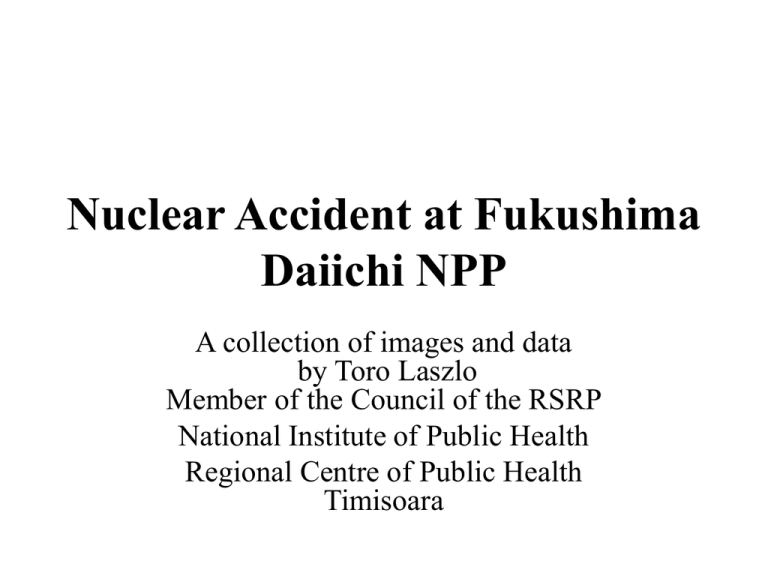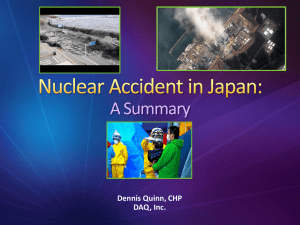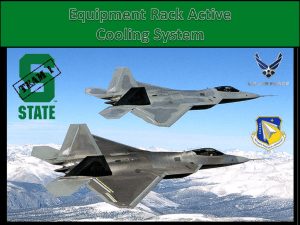Fukushima Daiichi nuclear accident
advertisement

Nuclear Accident at Fukushima Daiichi NPP A collection of images and data by Toro Laszlo Member of the Council of the RSRP National Institute of Public Health Regional Centre of Public Health Timisoara Accident cause •11/03/2011, 2:46 p.m. local time (7 hours earlier Romanian time) near the Japanese island of Honshu was an earthquake of 9 on the Richter scale. •The quake had an impact on section of north-east coast of Japan where they are located a series of nuclear power plants (NPP). •Nuclear reactors have been shut down properly. NPP DAIICHI before the earthquake Schema reactorului cu apa in fiebere al NPP DAIICHI Remanent heat in DAIICHI NPP Aszodi, 2011 Event description 12.03. • Units 4-6 in shut down status for periodic maintenance and refuelling • Units 1-3 were stopped automatically after the quake • Reactor buildings and the containment successfully resist to the earthquake • All reactor were dissconnected from the external AC supply • Backup sources (diesel generators) started • At approximately one hour after the earthquake tsunami hit the site – destroyed fuel tanks of the diesel generators – flooded the diesel generator building (10m protection wall was not sufficient) • Mobile generators were sent to the site in a short time but they ran out of fuel • Hydrogen Explosion Unit 1 • Evacuation of population from the area of 20km Daiichi NPP and 10km Daina NPP (approx. 200 000 person • On-site radioactivity increased Event description 13.03. • Lowering the internal pressure led to hydrogen explosion at unit 3 • Injection of sea water into the reactor vessel without cooling units at unit 1-3 • Variable on-site radioactivity • Increased radioactivity at Onagawa NPP (north of Daiichi) revealed that comes from Daiichi NPP Event description 14-15.03. • Cooling with seawater stopped at Unit 2 (unknown cause), variable water level in the reactor • Hydrogen Explosion at Unit 2 • Cooling with sea water stopped at all units due to lack of fule and water source • Fire then explosion in the spent fuel storage pool at unit 4 (relatively fresh fuel) • Restart seawater injection in the reactor wessel at all units • Significant radioactive emission • Housing on the area of 20-30 km • Risk of melting the core and damage of the containment at Unit 2 Daiichi NPP after hidrogen explosion 15.03. Daiichi NPP after hidrogen explosion 15.03. Event description 16.03. • Fire in spent fuel storage pool at Unit 4, cooling water evaporation • Water level decrease at Unit 5, taking water from Unit 6 • Unsuccessfull attempts to feed with cooling water and boric acid the spent fuel storage pool at Unit 4 • Possible melting (at least partially, 50%) of the core at Units 1 and 3 • Fill with water the reactor vessel of the Unit 2 • Lowering water levels in the spent fuel pool at Units 3 and 4 • Increasing temperature in the spent fuel pool at unit 5 and 6 • Cooling with water canons from the police departement Daiichi NPP after hidrogen explosion(16.03.) Event description 17.03. • Radioactivity observed outside of the site – Fukushima: 3-170 μSv / h (30 km from the NPP) – In two places increasing dose 80 to 170, and 26 to 95 μSv/h – Other directions 1-5 μSv/h • Begining actions to connect a cable for AC supply to unit 2 • Continue attempts for cooling Unit 4 with water from helicopters (without succes) then with water canons • One of the diesel generators from Unit 6 supplies Unit 5 for cooling spent fuel storage pool and the reactor wessel Event description 18-19.03. • • • • • • An auxiliary transformer connected to external power source Actions to connect units 3 and 4 to AC power Actions to connect units 5 and 6 to AC power A backup generator from unit 6 repaired Continue seawater injection into the reactor vessel at Units 1-3 Cooling unit 3 with water canons provided by police and fire departement units (civil defense, fire rescu units from Tokioand U.S. army), unit 3 is considered cooling enough • Considering additional cooling the spent fuel pools from Unit 4 • At 5 AM, 19.03 starting pump C of the shutdown cooling system of unit 3, used to cool the spent fuel storage pool. • Restart cooling Unit 4 with water cannons, in collaboration with civil defense. Event description 20.03. • Continue works connect to the power supply units 3 and 4. • Continue cooling units 3 and 4with water cannons • Continue filling the spent fuel storage pools • Water injection is continued in reactor vessels of units 1-3 Event description 20-21.03 • • • • • • • • • • • Three holes are driven in the roof of reactor building units 5 and 6 to prevent hydrogen accumulation At around 15.55 light gray smoke is observed from the southpart of the 5th floor of Unit 3 Parameters of the reactor vessel and containment are not change significantly Increase of radioactivity is subsequently found that returns to lower levels later For security reasons work is stoped and personnel withdraw from unit 3 Smoke changing color to white and slowly disappears Ends connecting a cable from the main transformer of the temporary substation. It begins to restore power supply of units 3, 4, 5 and 6 It restores the power supply from diesel generator of Unit 5 March 21 the presence of radioactivity in seawater is detected near southern discharge channel near of the Daiichi NPP Cobalt, iodine and cesium is identified in seawater Concentration in sea water (Bq/l) 21.mar 22.mar Co-58 59,5 16,7 I-131 5010 1190 I-132 2100 1360 Cs-134 149 150 Cs-136 213 235 Cs-137 148 153 Event description 22.03. • Ends cable connecting the power supply to unit 2, the supply of of the entry side starts • White smoke seen in Unit 2, until the morning of 22.03 it disappears • White smoke at unit 3, disappears • Continue water cooling units 2, 3 and 4, at unit 4 a concrete pumping device is used to fill the spent fuel storage pool • Iodine and cesium is detected in the air at the site sampling points Event description 23.03. • Begins the injection of sea water in unit 2 using the normal cooling system • Continue injecting sea water into unit 1 and 3 • The power supply of units 1-6 is restored, the main control rooms are connected to the AC supply • It began work on restoring power supply of the systems of all units • Continue injecting seawater in the spent fuel storage pool of units 3 and 4 • At 16.20, 23.03 a gray smoke is observed at unit 3, for security workers from the control room and around Unit 3 are evacuated • Smoke changes in white and disappears slowly • Subsequently found that radioactivity is increasing and decrease more slowly to the initial values • End of water feed of the spent fuel storage pool of Unit 4 Green smoke at Unit 3 (23.03.) Dose rates on the NPP site– sampling point MP6 (μSv/h) Dose rates on the NPP site– sampling point MP4 (μSv/h) Dose rates on the NPP site– sampling point MP1 (nSv/h) Dose rates in Ibaraki prefecture (μSv/h) 7 Dose rate (microSv/h) 6 5 4 3 2 1 0 1 15 29 43 57 71 85 99 113 127 141 155 169 183 197 211 225 239 253 267 281 295 309 323 337 351 365 379 393 407 JAEA NS JAEA NF Tokyo University Dose rates in prefectures (μSv/h) 0,5 0,4 0,3 0,2 Hokkaido(Sappro) Akita(Akita) Toshigi(Utsunomiya) Tokyo(Chinjyuku) Ichikaw a(kanazaw a) Gifu(Kakumuhara) Shiga(Otsu) nara(Nara) Okayama(Okayama) Kagaw a(Takamastu) Shiga(Shiga) Miyazaki(Miyazaki) Aomori(Aomori) Yamagata(Yamagata) Gunma(Maebashi) kanagaw a(Chigasaki) Fukui(Fukui) Shizuoka(Shizuoka) Kyoto(Kyoto) Wakayama(Wakayama) Hiroshima(Hiroshima) Ehime(Matsuyama) Nagasaki(Ohmura) Kagoshima(Kagoshima) Iw ate(Morioka) Fukushima(Futaba) Saitama(Saitama) Niigata(Niigata) Yamanashi(Kohu) Aichi(Nagoya) Osaka(Osaka) Tottori(Tohhaku) Yamaguchi(Yamaguchi) Kochi(Kochi) Kumamoto(Uto) Okinaw a(Uruma) 10_11 3_4 20-21 13-14 6_7 23-24 16-17 9_10 2_3 19-20 12_13 5_6 22-23 15-16 8_9 1_2 18-19 11_12 4_5 21-22 14-15 7_8 0 0-1 0,1 17-18 Dose rate (microSv/h) 0,6 MIyagi(Sendai) Ibaraki(Mito) Chiba(Ishihara) Toyama(Imizu) Nagano(Nagano) Mie(Yokkaichi) Hyogo(Kobe) Shimane(Matsue) Tokushima(Tokushima Fukuoka(Dazaifu) Oita(Oita) Drinking water (mBq/kg) I-131 and Cs-137 in tape water (mBq/kg) 100000 10000 1000 100 10 1 18.03.2011 Hokkaido I-131 Aomori Cs-137 Miyagi I-131 Akita Cs-137 Fukushima I-131 Ibaraki Cs-137 Gunma I-131 Saitama Cs-137 Tokyo I-131 Kanagaw a Cs-137 Toyama I-131 Ishikaw a Cs-137 Yamanashi I-131 Nagano Cs-137 Shizuoka I-131 Aichi Cs-137 Shiga I-131 Kyoto Cs-137 19.03.2011 20.03.2011 Hokkaido Cs-137 Iw ate I-131 Miyagi Cs-137 Yamagata I-131 Fukushima Cs-137 Tochigi I-131 Gunma Cs-137 Chiba I-131 Tokyo Cs-137 Niigata I-131 Toyama Cs-137 Fukui I-131 Yamanashi Cs-137 Gifu I-131 Shizuoka Mie I-131 Shiga Cs-137 Osaka I-131 21.03.2011 Aomori I-131 Iw ate Cs-137 Akita I-131 Yamagata Cs-137 Ibaraki I-131 Tochigi Cs-137 Saitama I-131 Chiba Cs-137 Kanagaw a I-131 Niigata Cs-137 Ishikaw a I-131 Fukui Cs-137 Nagano I-131 Gifu Cs-137 Aichi I-131 Mie Cs-137 Kyoto I-131 Osaka Cs-137 fall out (kBq/m2 ) Fall out (kBq/m2) 100,00 80,00 60,00 40,00 20,00 0,00 18.08-19.03 19.08-20.03 20.08-21.03 21.08-22.03 22.08-23.03 Hokkaido I-131 Hokkaido Cs-137 Aomori I-131 Aomori Cs-137 Iw ate I-131 Iw ate Cs-137 Miyagi I-131 Miyagi Cs-137 Akita I-131 Akita Cs-137 Yamagata I-131 Yamagata Cs-137 Fukushima I-131 Fukushima Cs-137 Ibaraki I-131 Ibaraki Cs-137 Tochigi I-131 Tochigi Cs-137 Gunma I-131 Gunma Cs-137 Saitama I-131 Saitama Cs-137 Chiba I-131 Chiba Cs-137 Tokyo I-131 Tokyo Cs-137 Kanagaw a I-131 Kanagaw a Cs-137 Niigata I-131 Niigata Cs-137 Toyama I-131 Toyama Cs-137 Ishikaw a I-131 Ishikaw a Cs-137 Fukui I-131 Fukui Cs-137 Yamanashi I-131 Yamanashi Cs-137 Nagano I-131 Nagano Cs-137 Gifu I-131 Gifu Cs-137 Shizuoka I-131 Shizuoka Aichi I-131 Aichi Cs-137 Mie I-131 Mie Cs-137 Shiga I-131 Shiga Cs-137 Kyoto I-131 Kyoto Cs-137 Osaka I-131 Osaka Cs-137 Hyogo I-131 Hyogo Cs-137 Nara I-131 Nara Cs-137 Wakayama I-131 Wakayama Cs-137 Tottori I-131 Tottori Cs-137 Shimane I-131 Shimane Cs-137 Okayama I-131 Okayama Cs-137 Hiroshima I-131 Hiroshima Cs-137 Yamaguchi I-131 Yamaguchi Cs-137 Tokushima I-131 Tokushima Cs-137 Kagaw a I-131 Kagaw a Cs-137 Ehime I-131 Ehime Cs-137 Kochi I-131 Kochi Cs-137 Fukuoka I-131 Fukuoka Cs-137 Shiga I-131 Shiga Cs-137 Nagasaki I-131 Nagasaki Cs-137 Possible dispersion of the cloud Dose rates on the NPP site Romanian situation • Radioactive cloud will not reach or will reach a very low concentration (m or μBq/m3) due to long distance (high dilution) • From the event will not result a Chernobyl type contamination: – Much lower emission time and intensity – Emission composition totally different, less a few orders of magnitude – Much greater distance • There is a "crisis cell" at the regulator, CNCAN • Press release on the website of the Ministry of Health and the Romanian Society of Radioprotection • The population is warning: – Stable iodine administration is not necessary – Risks of stable iodine administration without medical suprevision • There are no radiological risk for potential tourists to the Far East • Urgent measures are not necessary Daiichi NPP one minute before explosion at Unit 3 Daiichi NPP three minutes after explosion at Unit 3 Infrared photos of Daiichi NPP








